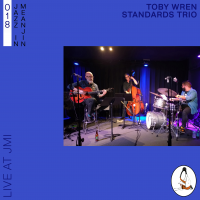Home » Jazz Musicians » Adam Rogers
Adam Rogers
For eleven years he co-led the innovative and critically acclaimed group Lost Tribe, which has toured nationally and internationally, releasing three albums. Adam has also been featured performing, touring and recording with artists such as Michael Brecker, Cassandra Wilson, Norah Jones, Walter Becker ( of Steely Dan ), Regina Carter, John Zorn, Randy Brecker, Laurie Anderson, The Mingus Orchestra, Terence Blanchard, Simon Shaheen, The Gil Evans Orchestra, John Pattitucci, Ravi Coltrane, Bill Evans, Lizz Wright, The Brecker Brothers, Jacky Terrasson, Kenny Barron, George Russell, Brian Blade, Eliane Elias, Alana Davis, David Krakauer, The Neptunes, Giora Feidman, Jack Mcduff, Larry Coryell, Chris Potter and Ronald Shannon Jackson among others, as well as playing music for the theater with The Great Lakes Theater Company, Joseph Papp's Public Theater and The Metropolitan Opera. In the summer of 1999 he was the featured soloist with the Dresden Symphony Orchestra performing John Mclaughlin's "Apocalypse". He has also maintained a presence in the N.Y.C. studio world having played on the soundtracks of numerous films and television commercial jingles.
Recently, Adam has been focusing more on recording and performing original music with his own groups. His debut CD on Criss Cross Records, “Art of the Invisible”, featuring Edward Simon-Piano, Scott Colley-bass and Clarence Penn-Drums, was released in 2002. The follow up, “Allegory”, in 2003, is with the same rhythm section plus Chris Potter on Saxophone. Featuring the group from "Allegory", his third release, “Apparitions”, was released in April 2005. A new trio record, “Time and the Infinite” with Scott Colley and Bill Stewart was released in February of 2007.
Adam resides in N.Y.C.
Gear
Tags
Clarence Penn: Behind the Voice

by Dan Bilawsky
Drummer Clarence Penn, a serious force on the scene for more than three decades, has worked with a who's who of vocalists--Betty Carter, Kandace Springs, Luciana Souza, Kate McGarry, Nellie McKay, Claudia Acuña, Paula Cole, Melissa Walker and Nneena Freelon, to name just a few. He knows more than a thing or two about history and creativity behind the voice, and he's here to show it with this sharply-constructed date. Working with a stacked lineup of singers and instrumentalists, and ...
Continue ReadingYelena Eckemoff: I Am a Stranger in This World

by Mark Sullivan
Russian-born pianist/composer Yelena Eckemoff began setting verses from the Bible's Book of Psalms shortly after her conversion to Christianity, even before her emigration to the United States. But she waited until she had considerable experience working with jazz musicians before producing her jazz arrangements. They were first recorded on her album Better Than Gold and Silver [L&H Production, 2018], which presented ten Psalm settings in both vocal and instrumental versions. The detailed story of how Yelena Eckemoff came to set ...
Continue ReadingAlternative Guitar Summit: Honoring Pat Martino, Volume 1

by Jack Bowers
Each year the Alternative Guitar Summit, led by Joel Harrison, presents a concert to honor a living jazz composer/guitarist. That wasn't possible in 2021, however, as venues in and around New York City were shuttered tight by the Covid-19 pandemic. Meanwhile, it was clear that the chosen honoree, the great Pat Martino, was gravely ill and might not have another year to live. With that in mind, members of the Summit took their guitars straight to a studio to record ...
Continue ReadingEdward Simon: 25 Years

by Angelo Leonardi
Al pubblico del jazz non piacciono molto le compilations ma questa del pianista Edward Simon è speciale. I diciassette brani del doppio CD sono stati scelti da lui--come bilancio e riflessione personale nel 25° anno della sua attività da leader--e forniscono una variopinta retrospettiva delle sue tappe musicali. «L'idea mi è venuta l'anno scorso (2019) quando ho compito 50 anni--ha detto al Columbia Daily Tribune--La raccolta è nata da uno spirito di celebrazione e dalla consapevolezza di quante cose siano ...
Continue ReadingOz Noy: Snapdragon

by Mike Jacobs
It's an old sentiment but it still holds that great instrumental chops, enthralling as they may be, are fairly meaningless on their own. And quite frankly, they are pretty ubiquitous these days with the internet exposure machine going full tilt. Given all that, it's quite easy for the listener to become inured with technical prowess-- especially wizardry of the fretboard. So to say Oz Noy is a fantastic guitarist just isn't enough anymore. It's fortunate then that what ...
Continue ReadingEdward Simon: 25 Years

by Dan McClenaghan
Pianist Edward Simon immigrated to the United States from his native Venezuela while still in his teens. He stayed, and carved out a successful career in music. His fiftieth birthday rolled around, and the artist decided it was time to take a look and listen back. In a musical journey that spans the titular 25 Years, Simon has crafted a lot of music, employing a Latin/jazz/classical approach with a seemingly effortless refinement, making sounds that are unfailingly engaging and beautiful. ...
Continue ReadingGabe Terracciano: In Flight

by Ian Patterson
Comes a time when every fledgling must leave the nest. Since making his recorded debut on Ron McClure's Crunchtime (Steeplechase Records, 2012), Portland-born, New York-based Gabe Terracciano has worked in everything from the riotous jazz-filtered bluegrass of the Harmolodic String Band and the groundbreaking chamber iconoclasts Turtle Island Quartet, to the Ghanaian National Symphony Orchestra. With In Flight Terracciano takes the leap with his debut as leader. Heading a line-up of some of New York's finest, Terracciano introduces six original ...
Continue ReadingFrost Concert Jazz Band Under The Direction Of John Daversa Releases Concerto For Guitar And Jazz Orchestra By Justin Morell, Featuring Adam Rogers

Source:
Mouthpiece Music
Jazz is an art form that allows musicians to drawn upon an endless array of stylistic and cultural traditions. While a number of jazz artists have incorporated the sophisticated forms of classical music in their writing and performances, there are few true concerto works for a jazz orchestra and fewer still composed for guitar. On Concerto for Guitar and Jazz Orchestra, three master musicians have joined forces to create a project of great beauty and depth. The music is composed ...
read more
Dekel Bor Trio Featuring Adam Rogers tonight at Smalls

Source:
All About Jazz
The Dekel Bor Trio is delighted to invite you to the band's last 4 NYC shows until July 2007.
As they prepare to record their next album with Grammy-winning producer Robert Sadin, the trio will be playing every Wednesday in December at Smalls - every week with a very special friend as a guest.
Dec. 6th , 10pm-1:30 am
Dekel Bor Trio featuring Adam Rogers:
Dekel Bor - Guitar Hans Glawishnig - Bass Nadav Snir-Zelniker - Drums
read more
Guitarist Adam Rogers with Chris Potter, James Genus, Jeff Tain Watts November 6 @ Jazz Gallery

Source:
All About Jazz
November 6th with Chris Potter, James Genus, Jeff Tain Watts $12 / 9pm & 10:30pm / 212-242-1063 290 Hudson Street @ Spring Street
Adam Rogers has forged a reputation as one of the best finest guitarists in the world by way of his starring role with many of the greatest in jazz, pop and world music: Walter Becker (of Steely Dan); Brian Blade; Terence Blanchard; Michael and Randy Brecker; Regina Carter; Ravi Coltrane; Larry Coryell; Elvis ...
read more
"Intelligent, inventive, technically brilliant, Rogers in now clearly one of the finest guitarists around" - Ray Comiskey, The Irish Times
"(an) exceptional Guitarist.." - Bob Blumenthal, Boston Globe
" A searing electric solo by Rogers" - Jazz Times
“One of the best Guitarists of the Century”- Dresden Zeitung
Steven Kirby
guitarJohn Kozinski
guitarKevin Brown
guitarGüç Başar Gülle
guitarPC ENERGETIC
band / ensemble / orchestraPrawit Siriwat
guitarMarc Crofts
violinCarlos Alberto Jiménez
guitarPhotos
Music
Send One Your Love
From: Behind the VoiceBy Adam Rogers











































